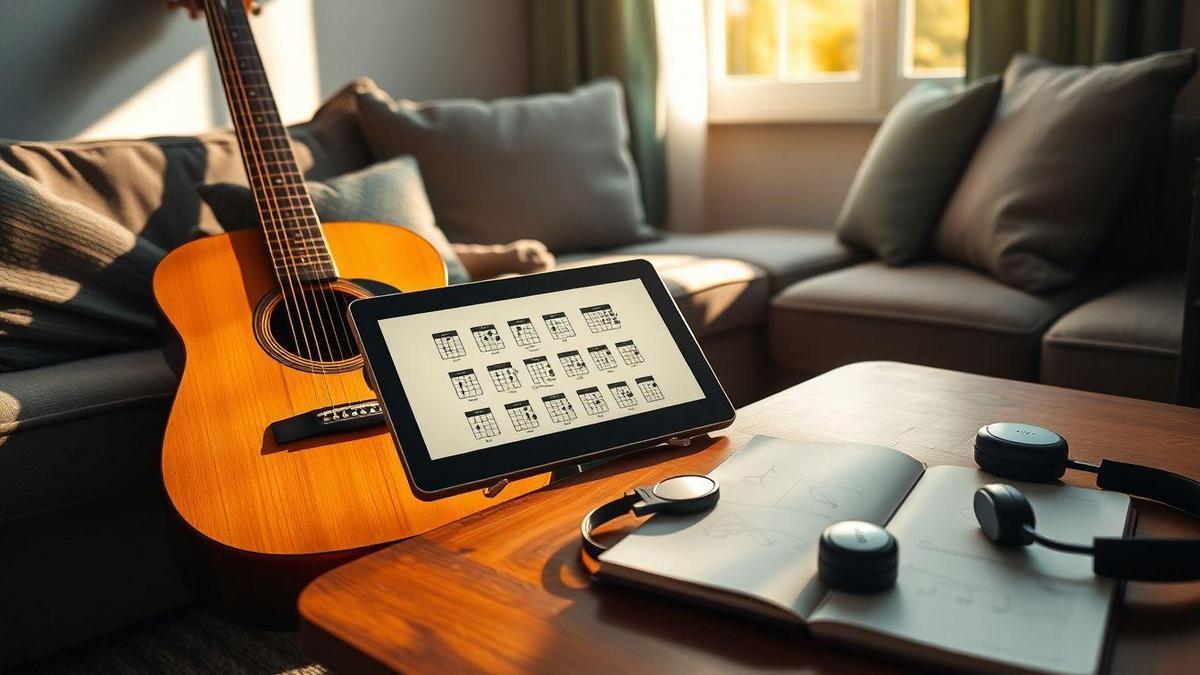How to Learn Guitar from Scratch at Home: Complete Guide for Beginners
This practical guide—How to Learn Guitar from Scratch at Home: Complete Guide for Beginners—gives you a clear, step‑by‑step path to play and care for an acoustic guitar at home. You’ll get setup and maintenance tips, fast tuning routines, the first open chords, basic strumming and fingerpicking patterns, tab reading essentials, and a short daily practice plan to build real progress.
Key takeaways
- Practice 15–25 minutes daily to build finger memory.
- Start with a few open chords (G, C, D, Em, Am) and learn smooth changes.
- Use a metronome and a steady strumming pattern.
- Break songs into small parts and repeat slowly.
- Set weekly goals and log progress.
Setup & maintenance — get comfortable fast
A well‑set guitar invites you to play. Small fixes save time and frustration.
Choose the right size, action, and strings
- Body size: dreadnoughts are loud; concert/parlor are easier to hold. Pick what fits your frame.
- Action (string height): lower action is easier to fret; higher action gives more tone but tires fingers. Aim for a comfortable middle.
- Strings: light gauge (.010) is easier for beginners; medium (.011) adds tone. Coated strings last longer. Nylon is for classical guitars.
Quick rule: if you’re under 5’6″ or have short arms, try a smaller body and light strings.
Quick checks before you play
- Neck: look down the neck for a small bow. Big bow/back‑bow needs a setup.
- Frets: press strings at each fret; buzzes or dead spots mean service.
- Tuners & nut: tuners should turn smoothly and hold tuning; graphite in nut slots stops binding.
- Always tune before playing and gently stretch new strings.
Daily cleaning and storage
- Wipe strings and bridge after each session to remove oils.
- Change strings when dull or unstable — every 4–8 weeks if you play daily.
- Clean fretboard lightly when changing strings; use fretboard oil sparingly.
- Store in a case or on a stand, away from heat and direct sun; use a humidifier in dry climates.
Learn to tune quickly and keep it in tune
Tuning is the first skill you’ll use every session. Use a tuner or train your ear.
Tuners vs. tuning by ear
- Clip tuners and apps are fast and accurate.
- Ear method: get a reference pitch (A=440), tune low E, then use the 5th‑fret method: E(5)→A, A(5)→D, D(5)→G, G(4)→B, B(5)→E. Check octaves at the 12th fret.
Tips: always tune up to pitch (tighten past and ease back). New strings stretch — retune frequently at first.
Quick two‑minute tuning routine
0–15s: open your tuner or app and get low E close.
15–45s: tune E, A, D, G, B, E roughly.
45–75s: fine‑tune and play a few chords.
75–90s: stretch new strings and retune.
90–120s: strum and verify; you’re ready.
Check tuning before each practice and when temperature/humidity changes.
Learn basic chords and play easy songs
If you follow How to Learn Guitar from Scratch at Home: Complete Guide for Beginners, focus on comfort, tuning, a handful of chords, and simple songs.
Start with these open chords
G, C, D, Em, Am — these use open strings and give instant song options.
Practice one chord until you can strum it cleanly three times in a row. Keep fingers curved, press near frets, and keep the thumb behind the neck.
Build chord‑change skills
- Practice two‑chord switches slowly with a metronome.
- Find an anchor finger that stays between shapes to reduce travel.
- Use short cycles: 5 minutes on shapes, 10 minutes on switching, then play a song twice.
5‑day starter plan (compact)
- Day 1: Learn shapes for G, C, D.
- Day 2: Practice switching G↔C and G↔D.
- Day 3: Add a simple down‑up strum pattern.
- Day 4: Put chords into a short song (G–C–D).
- Day 5: Record a take and note one thing to improve.
Read tabs and follow beginner lessons at home
Tabs get you playing melodies and riffs quickly without full notation.
Tab basics
- Six lines = strings (high E to low E). Numbers = frets (0=open). Left→right = time.
- Common symbols: h (hammer‑on), p (pull‑off), / or (slide), b (bend), x (mute).
Mini exercise: play 0‑2‑4‑2‑0 on one string slowly until smooth. Break long tabs into 4‑bar chunks.
Learning method
- Watch one short lesson, practice the exact moves, repeat until comfortable.
- Record 30‑second clips weekly to track improvement.
Build an efficient practice routine
Short, focused sessions beat irregular long practices.
Divide each session
- Warm‑up (2–3 min): single‑finger moves up and down a string.
- Chords (5–7 min): shape work and switching.
- Strumming (5 min): steady patterns with a metronome.
- Songs (5–7 min): apply what you practiced.
Sample 20‑minute routine
0–3 min: finger warm‑ups.
3–8 min: chord practice (two chords switching).
8–13 min: strumming patterns (down beats → down‑up).
13–18 min: song run‑through (two passes).
18–20 min: quick log — note one win and one focus.
Track date, time, and a single goal (e.g., smooth G→C).
Strumming and fingerpicking basics
Give the right hand consistent time alongside left‑hand work.
Common strumming pattern
Count 1 & 2 & 3 & 4 &: try down — down‑up — up‑down‑up. Start at 60 BPM, keep the wrist loose, accent beat 1, and speed up only when clean at slower tempo.
Starter fingerpicking
- Thumb for bass (E/A/D), fingers for G/B/e.
- Try thumb → index → middle → index over one chord.
- Drill: thumb only for 60s, then add fingers one at a time.
Five daily techniques (5–10 minutes each)
1) Slow alternate strumming at 50–60 BPM.
2) Chord changes with metronome (switch every two measures).
3) Thumb bass (beats 1 & 3) for independence.
4) Basic arpeggio: T‑I‑M‑I pattern on open chords.
5) Palm muting and dynamics: practice loud/soft control.
Conclusion
How to Learn Guitar from Scratch at Home: Complete Guide for Beginners gives you a clear roadmap: set up your guitar, tune quickly, learn a few open chords, practice steady strumming and basic fingerpicking, read simple tabs, and use a short daily routine. Short, consistent practice and small weekly goals produce real progress. Clean strings, comfortable action, and regular tuning keep the instrument playable and inspiring.
For more step‑by‑step lessons and tips, explore additional resources at https://sambizangamusik.com.
Frequently asked questions
Q: How to Learn Guitar from Scratch at Home: Complete Guide for Beginners?
A: Follow a clear plan: tune, learn posture and two or three chords, practice chord switching and a simple strum, and play a short song each day.
Q: How many minutes a day should you practice?
A: Aim for 15–25 minutes daily. Add another short session if possible. Consistency matters more than duration.
Q: What home exercises speed progress?
A: Chord changes, single‑note drills, basic scales, rhythm practice with a metronome, and slow repetition.
Q: Do you need a teacher or can you learn alone?
A: You can learn alone using quality apps and video lessons, but occasional teacher check‑ins help correct bad habits.
Q: What basic gear do you need?
A: A guitar, a tuner (clip or app), picks, and a metronome app. Add a strap, capo, and case as you go.













